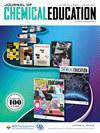利用廉价的三维打印光反应器,通过 1H NMR 光谱和计算模型监测 2-硝基肉桂醛的能量转移光催化 (E) → (Z) 异构化反应
IF 2.9
3区 教育学
Q2 CHEMISTRY, MULTIDISCIPLINARY
引用次数: 0
摘要
(Z)-烯的合成具有挑战性,因为(E)立体异构体通常更为稳定。能量转移光催化已成为(E)→(Z)烯异构化的有效策略。我们报告了一个高级本科生实验室实验的发展情况,该实验以能量转移光催化 2-硝基肉桂醛的 (E) → (Z) 异构化为背景,向学生介绍了当代有机光催化方法和理论。学生们评估了光催化剂 [Ru(bpy)3][PF6]2 和 [TPP][BF4] 促进底物异构化的能力,通过 1H NMR 光谱监测和分析了反应,并通过计算化学探究了异构化机理。这项研究使用了威斯康星光反应器平台(Wisconsin Photoreactor Platform),该平台提供经济实惠、易于制造和可靠的光反应器。本文章由计算机程序翻译,如有差异,请以英文原文为准。

Energy Transfer Photocatalytic (E) → (Z) Isomerization of 2-Nitrocinnamaldehyde using an Inexpensive, 3-D Printed Photoreactor Monitored by 1H NMR Spectroscopy and Computational Modeling
Synthesis of (Z)-alkenes is challenging because the (E) stereoisomers are usually more stable. Energy transfer photocatalysis has emerged as an efficient strategy for (E) → (Z) alkene isomerization. We report the development of an advanced undergraduate laboratory experiment that introduces students to contemporary organic photocatalysis methods and theory within the context of the energy transfer photocatalyzed (E) → (Z) isomerization of 2-nitrocinnamaldehyde. Students assess the ability of the photocatalysts [Ru(bpy)3][PF6]2 and [TPP][BF4] to promote substrate isomerization, monitor and analyze reactions by 1H NMR spectroscopy, and probe the isomerization mechanism via computational chemistry. This work uses the Wisconsin Photoreactor Platform, a source of affordable, readily fabricated, and reliable photoreactors.
求助全文
通过发布文献求助,成功后即可免费获取论文全文。
去求助
来源期刊

Journal of Chemical Education
化学-化学综合
CiteScore
5.60
自引率
50.00%
发文量
465
审稿时长
6.5 months
期刊介绍:
The Journal of Chemical Education is the official journal of the Division of Chemical Education of the American Chemical Society, co-published with the American Chemical Society Publications Division. Launched in 1924, the Journal of Chemical Education is the world’s premier chemical education journal. The Journal publishes peer-reviewed articles and related information as a resource to those in the field of chemical education and to those institutions that serve them. JCE typically addresses chemical content, activities, laboratory experiments, instructional methods, and pedagogies. The Journal serves as a means of communication among people across the world who are interested in the teaching and learning of chemistry. This includes instructors of chemistry from middle school through graduate school, professional staff who support these teaching activities, as well as some scientists in commerce, industry, and government.
 求助内容:
求助内容: 应助结果提醒方式:
应助结果提醒方式:


